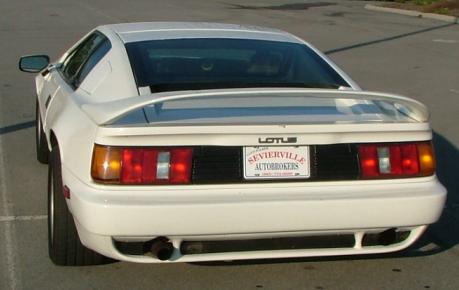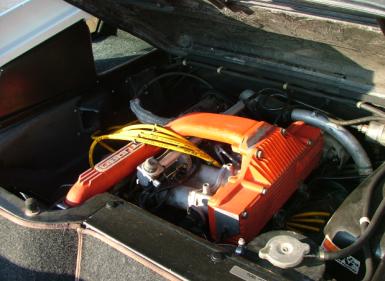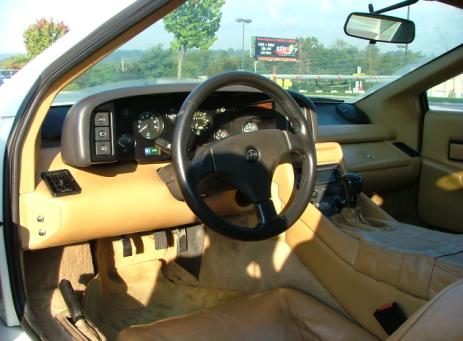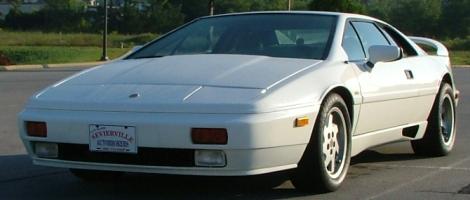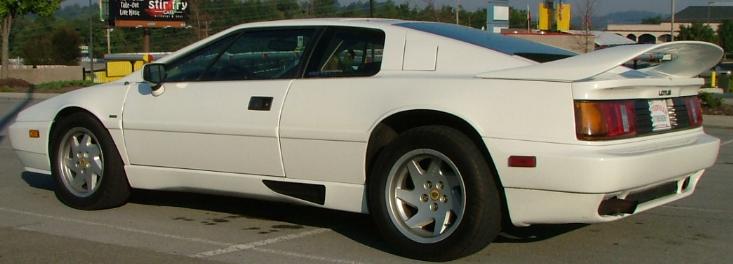
'89 Lotus Esprit Turbo...tomorrow
Driven: Lotus Esprit Turbo
Historically speaking, I hold a predilection towards Italian cars. Ferrari and Lamborghini specifically possess certain mystique: Ferrari with inimitable passion and history, and Lamborghini with cutting edge design and attitude. In my money-no-object garage, more than half would be pasta-rockets. I consider my taste in cars sufficiently diverse, and I respect nearly any car of merit for what it represents; be that shameless rally-derivative aggression, pure opulent luxury, or laser-focused track-day weapon. Really, I prefer Italian cars over others in the same way I tend to prefer brunettes to blondes. That is to say, given equal “equipment”, it serves as a tiebreaker only. I would no sooner turn down a date with a smashing golden-locked lass, than I would give up the chance to drive something as unique and accomplished as…a Lotus Esprit Turbo for instance. Now, on to the obligatory history lesson: If you’re not interested, feel free to skip a paragraph.
When the Esprit first came on the scene in 1976 it looked like a doorstop; a very well proportioned doorstop, but a plastic wedge none-the-less. It represented the styling trend of the time; witness the Lamborghini Countach, and Ferrari 308 GT4 Dino. However, unlike the Italians, the British don’t bother keeping up with every trend and fad. As a result the Esprit’s styling evolved slowly...no…no it didn’t. Barring a slight rounding of the edges in 1987 and a few different wings, nothing really changed up through 2004 when the last one rolled off the line in Hethel, England. The Performance though, THAT evolved. The original housed a 2.2 liter 4 cylinder that put out a modest 160hp. Lotuses (or Loti?) have always been more about handling than blunt speed but even so, that seems a bit limp-wristed. Of course the recipe for more power from a small engine reads simply: “just add turbo”. The blown version (yes, I said “blown”, ha ha) up through 1989 (including today’s Esprit-in question) put out a more muscular 215hp…and that in a car weighing less than your average Civic. Needless to say, it’s quick. 60mph comes and goes in 5.4 seconds according to literature, and the car tops out at a respectable 160mph, which is probably enough. Lotus, apparently, differed in that opinion and went bonkers in ‘89 beginning with the SE turbo which, with liquid charge-cooling, put out 264hp. The 4-cylinder Esprit reached zenith in 1995 with the S4S, a 300hp rocket. Then, in 1996, the four-banger got swapped for a twin turbo V-8 (yeah, that’s right, cubes AND forced induction) that remained through the end of production.
Right, on to the fun: I’ve probably wanted to drive a Lotus Esprit ever since Roger Moore used one while playing James Bond. It has such a classic fast-looking shape; an impressionable ten-year-old couldn’t help infatuation. Fortunately for my fragile psyche it turns out the car drives nearly as well as I thought it should (and didn’t explode as the Bond cars tended to). This particular Example is a 1989 Turbo model (props to Sevierville Auto Brokers for the test drive)
. Being a seventeen-year-old car, there are a few of the requisite niggling issues. The interior, for instance, smells of gas because the rubber fuel lines behind the cockpit tend to seep. That’s ok though, you stop noticing after about five minutes…or until there’s a fire. The body, which is fiberglass, tends to creak and rattle a bit. Starting the car cold elicits a noise similar to what you hear after sticking a pile of legos in a blender. Apart from that though, there’s not much to dislike…unless you’re either shorter than 5’2”, in which case you won’t be able to reach the peddles (no slide adjustment on the seat), or taller than 6’2” in which case you just won’t fit at all.
As I watched the car roll into the parking lot of the, somewhat appropriate, fitness center, it struck me how athletic the Esprit looks relative to even a modern sports car. There are no fat fender flares, no gratuitous plastic bumper trim or side skirts, no “dubs”, no chrome, and no haughty badging. The Esprit has just enough body to cover the mechanical components and keep the occupants dry in the rain. With the exception of the (non-stock) spoiler on this car, the lines remain exceptionally clean. The stance exudes performance, and the rest of the design backs up the form-following-function mentality of Lotus engineers. Getting in and out requires a relatively high level of coordination if one plans on looking like something other than a retard. That said, once ensconced between the doorsill and transmission tunnel, the non-adjustable seat seems well placed, and the controls fall readily to hand. Some accounts complain of an overly small foot well…right, maybe if you’re wearing clown shoes. The pedals are well placed for heel-and-toe action, and require only enough pressure to remind you that they are working. The steering, with no power assist, requires some effort at parking speeds, but quickly lightens up once under way. Any fault would have to fall with the gearbox’s rubbery feel, which makes accurate shifting a hit-or-miss affair. To sum up the problem: It’s French. The indicator stalks and other controls along with the door mirrors were all pulled from Renault or Citroen parts tubs, and all feel like they might break off in your hand. So build quality isn’t the best…you’ll forget about it as soon as you step on the gas.
Underway, even in this relatively mild 215hp trim, the Esprit is proper fast. The 2.2-liter motor comes across as surprisingly torquey, allowing for easy one-gear cruising around town. The brakes, not that they have much to stop, work extremely well, and the steering provides excellent feedback, and puts the car exactly where you want it. Of course, the real fun comes when you jump on the throttle, mid-revs, in second gear. There’s just enough time to get excited and giggle a little before “WHAM”, the boost hits home, you sink a little deeper into the leather, and realize why Colin Chapman (Lotus founder) is considered a genius. His philosophy of performance through lightweight yielded an engineering core capable of producing in the Esprit, a car that only weighs 2800lbs dry. Couple that with Lotus’ renowned suspension know-how, and one has a car that easily hangs with far newer super-sports cars, and turns just as many heads.
My Verdict: There’s not much better to be had for $20,000. With a better gearbox, this could be an astonishingly good car. Being that I’m currently “In the market”, this one will bear serious consideration.
Linkage:
Statistics Courtesy of: Lotus Esprit World
